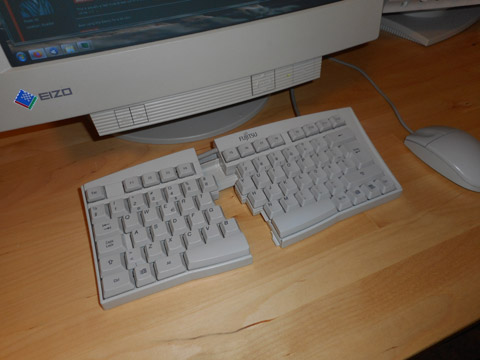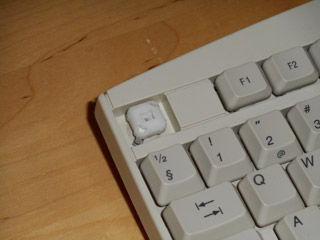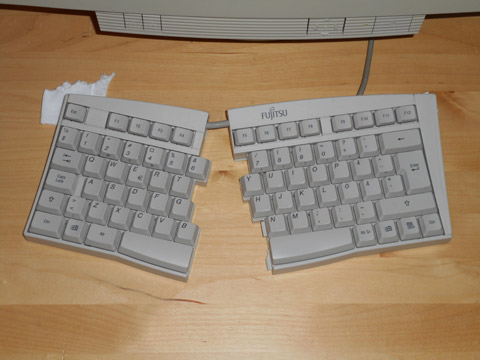
The Fujitsu FKB8530 is an optionally split keyboard with Fujitsu
rubber domes with sliders, without numpad and navigation keys. There appears to have been variants of the keyboard with
an extra section, providing a numpad and navigation keys, but if such a
section ever existed for my keyboard, it is now missing.
The construction of the splitting mechanism is a bit flimsy, but the build quality is generally good, and the keyboard feels solid to type on, especially when its feet are raised. The surface of the key caps wears out, becoming glossy, but the legends do not seem to fade away.
Even though the mechanism could be a little more solid, the keyboard can be split into two separate parts. It can also be used as a normal, non-split keyboard. Unfortunately, the two parts of the space bar seem to emit the same signal, so using them for different purposes seems to be impossible.
The layout is generally standard, but there are no extra keys to the
right of the Return key: no navigation keys, no Print Screen, no
numpad. Considering the apparent popularity of 60% keyboards, this may
not be an issue. Personally, I'm quite lost without navigation keys,
and while with help from AutoHotKey I've managed to cope, this is
definitely a drawback in my eyes. Key layers work very well when
typing, but less well when lazily browsing the web or watching videos.
The switches are rubber domes with sliders, which feel much nicer than normal rubber domes. The keys are very smooth, and there are no issues with binding. The keys have a pleasant, deep sound that is quieter than "mechanical" keys and somewhat reminiscient of Topre. They feel very soft, but not really mushy. In my opinion, the switches are quite excellent. Judging the FKB8530 from the typing experience only, I could definitely use it as my main keyboard.
Unfortunately, the keyboard suffers from ghosting issues, and while it certainly works for strategy games, it is not ideal for playing first-person shooters.
Overall, I recommend this keyboard. It is a good option if you are looking for something quite pleasant, fairly ergonomic, relatively compact and slightly unconventional. Its biggest assets are the keys and the switches, which are very smooth and quiet. The biggest drawback, at least for me, is that it is missing a lot of the normal useful keys.
If you're looking for other good rubber dome keyboards, check out my rubber dome buyer's guide.
As mentioned in the summary, the FKB8530 uses a switch type commonly referred to as dome with slider. There are a bunch of variations on this type of switch, but this specific one is called the Fujitsu dome with slider.

Fujitsu dome with slider.
As you can see from the picture, the sliders are rather large, large
enough that you could easily type on them without key caps. Each slider
has has two pins that extend through the outer layer of plastic. I'm
fairly certain that these pins are what actually stops the key, when
bottomed out, in contrast to rubber dome designs without sliders, where
nothing stops the key from depressing fully into the rubber dome,
resulting in the familiar mushiness. The Fujitsu domes with
sliders feel very soft and smooth when compared to most "mechanical"
switches, and I'd say they feel much less mushy than normal domes. I'd
reckon they are also a bit lighter than most rubber domes: if my
calculations are correct, then roughly 18 grams of force are needed to
get across the initial resistence.
Like other rubber dome switches, the Fujitsu domes with sliders are pleasantly tactile. In my estimation, however, they have less of the sudden drop, characteristic of rubber domes; although perhaps not quite as much as some other keyboards, they still provide a fair amount of resistence, but it is easier to avoid bottoming out after getting across the initial bump. I think this is because they don't have that sort of plastic-feeling friction which is characteristic of low-quality rubber domes.
Because they are rubber domes, these switches don't activate until fully bottomed out. I personally don't consider this a great problem. When typing, I find it hard not to bottom out the keys on this keyboard, and doing so isn't tiresome at all. But opinions vary.
I highly recommend these switches. I think they are a good
alternative to normal rubber domes. They are incredibly smooth, and I
personally consider them more comfortable than many "mechanical"
switches. They may, however, be too soft for some.
As I mentioned, the FKB8530 can be used in two ways: either normally or split. It is split along the 6/7, T/Y, G/H, B/N keys, which I think is fairly reasonable. I personally had to switch hands for the 6 and B keys, but it didn't take long to adjust.
To split the keyboard, you have to relax two thumb screws on the back of the keyboard, which hold in place a long, plastic bar, connecting the two sides of the keyboard. As I have no manual, and there is little information about this keyboard available online, I'm still not entirely sure how exactly you are supposed to use this mechanism. In any case, I've identified three ways.
The first option is simply not to split the
keyboard. It works perfectly fine as a normal, unsplit keyboard, and if
you are not interested in the ergonomic advantages of split keyboards,
then you don't need to split the keyboard at all.
The second option is to split the keyboard as much as possible, without disconnecting the plastic bar between the two sides, and then tighten the screws again. Let's call it a partially split setup. This is the setup I used for the picture at the top of this page (here). I'm not sure if this is intended. On the one hand, it feels a bit flimsy, as there is room for the plastic bar to move around, even when both screws are fully tightened. On the other hand, it gives the left side, which only has a single foot, a lot more stability when the keyboard is raised, as it is connected to the right side, which has two feet.
The third option is to entirely disconnect the plastic bar, shoving it, by moving the right screw, all the way into the left side of the keyboard, and then tighten the screws again. This is surely intended, as the plastic bar fits snugly into the left side. However, because the left side only has one foot, it is totally impractical to use the keyboard raised, when fully split like this. Really quite strange.

The keyboard in unsplit, partially split and fully split positions.
And because there are no softening rubber pads on the top-left and
top-right corners, the keyboard is quite rattly when its feet aren't
up. I was able to remove all rattle by placing two pairs of carefully
cut furniture pads on the corners of the keyboard. (If you don't have
any furniture pads, you can place two pieces of household paper under
the top-left and top-right corners in the meantime.)

The two parts of the keyboard fully split, softened by two pieces of household paper.
The benefit of the fully split position is that you can "tent" the keyboard – i.e. place the two sides on an angle relative to one another, in a shape similar to a tent or a roof. Supposedly, this is even more ergonomic. The drawback is that you would need some type of stand for this; I tried using books, with varying degrees of success.
As for the supposed ergonomic benefits of split keyboards in
general, I personally don't really notice anything. Once you've gotten
used to the split layout, it's rather nice to use, but I don't feel
that it really makes typing more comfortable in general. The drawback,
which I'm not entirely sure the benefits outweigh, is that some
one-hand key combinations are much harder (or impossible) to perform.
The most obvious example is Ctrl-Y.
Last updated on 21 Dec 2020.
© 2020 John Ankarström. Up
Comments • Submit